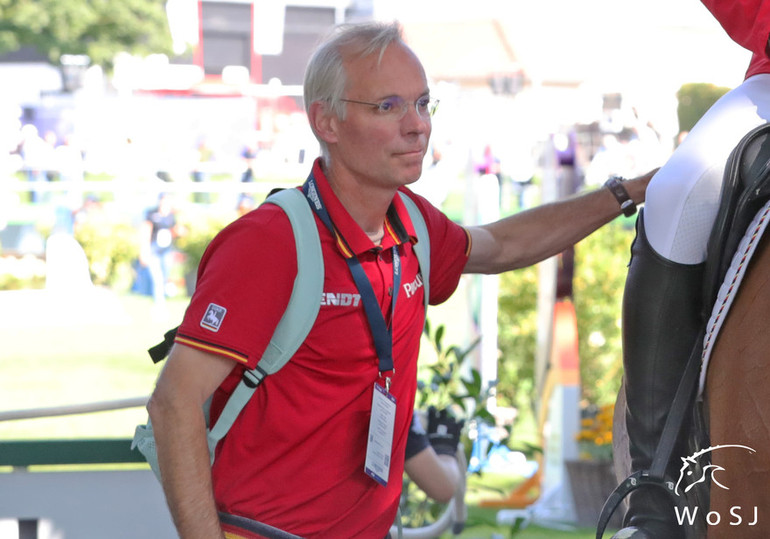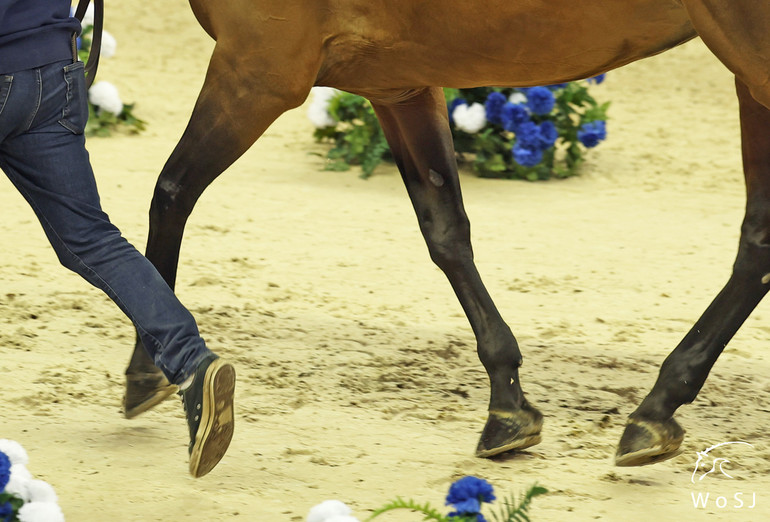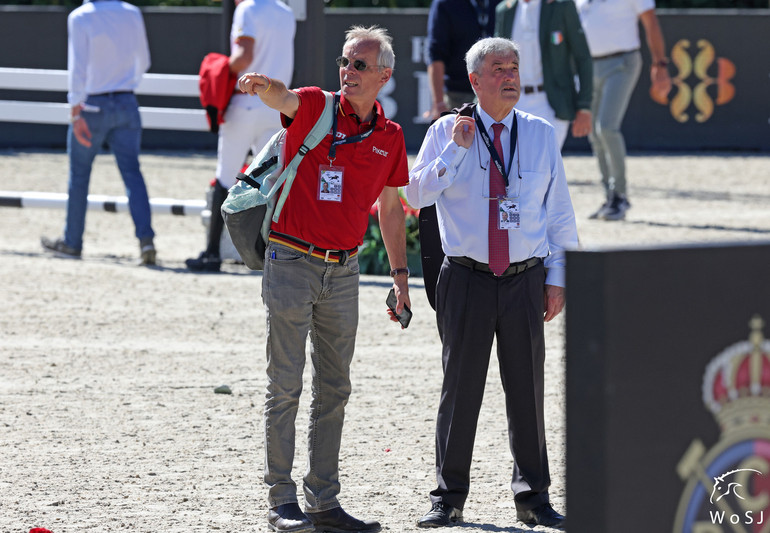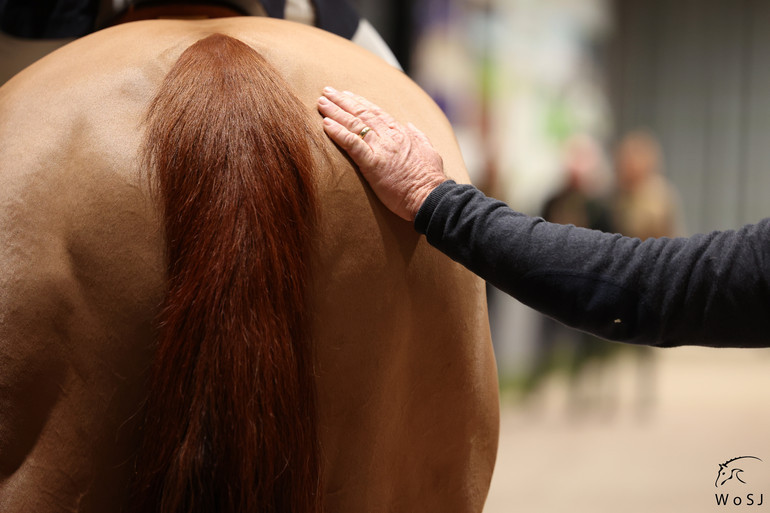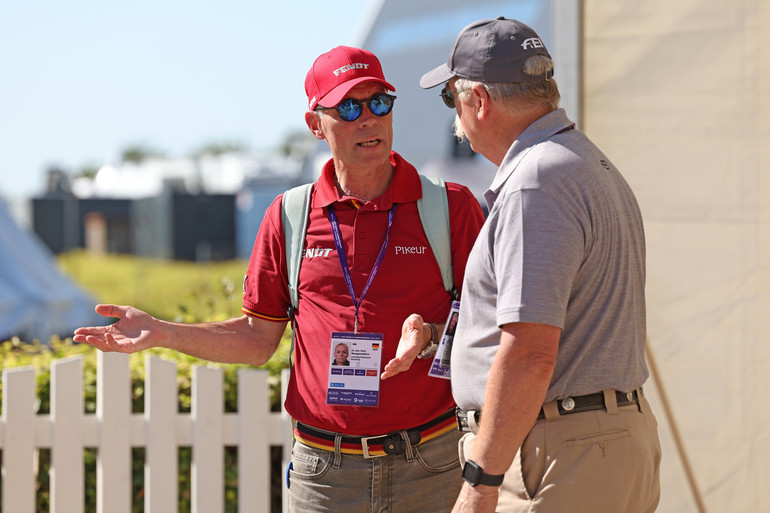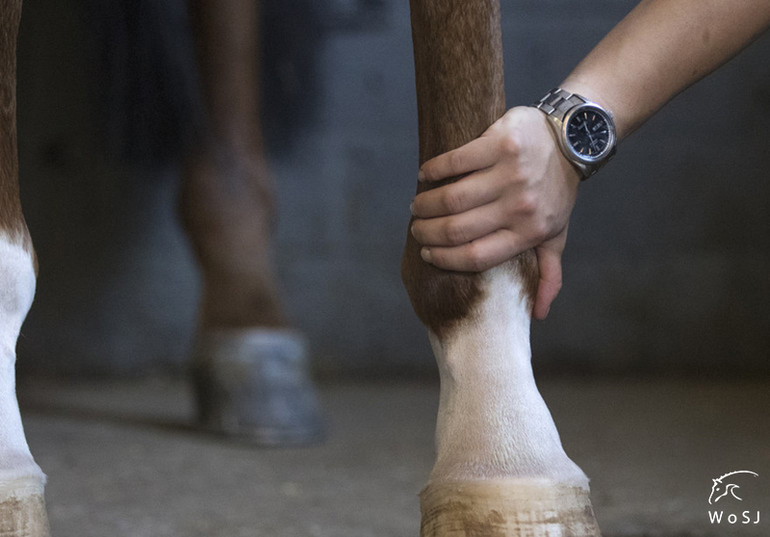Text © World of Showjumping
“I cannot stress this point enough; if you have any doubts about your horse – whether it feels disobedient or unhappy – it makes sense to have it checked,” Dr. Jan-Hein Swagemakers tells World of Showjumping. “We have to really listen to the horses, and be extremely careful about punishing them for not doing what they are asked to do, or think that they are just reluctant or stubborn – usually something is wrong and we should be very mindful of that.”
Dr. Jan-Hein Swagemakers is a FEI permitted treating veterinarian, an equine chiropractor and a well-known face on the international showjumping circuit: He has functioned as the German team veterinarian since 2009 and runs his own clinic – Tierklinik Lüsche in Germany. World of Showjumping asked Swagemakers to explain the basic principles of lameness assessment and where to draw the line when it comes to normal or slightly asymmetric movement.
“If you notice that your horse is uncomfortable, your first step should be to not expect it to perform – and you should not want the horse to perform either if you feel it is not a 100%,” he says. “I think most people who have horses can look at their face, see them move and know if the horse is happy or not. The moment your horse is not happy, shows discomfort or is not performing well, you should question if something is wrong. Sometimes these cues can be really marginal, but if you think something is not right, you should get your horse checked and diagnosed.”
“Lameness is basically a change of movement, of loading or of the range of motion of a limb, which is caused by a pathological change,” Swagemakers explains about the definition of lameness.
Lameness is an altered movement due to a dysfunction somewhere in the body
“Usually, these changes may come from any part of the limb – be it bone tissue, joints, tendon ligaments, muscle, nerve or any type of tissue. Lameness is an altered movement due to a dysfunction somewhere in the body, often it is accompanied by pain, or even caused by pain, while the pain in its turn usually is caused by an inflammation. That is the most common reason. However, there are many other types of lameness as well, like mechanical disturbances, altered situations in the neck or in the back, which may also cause a lameness – so it might not only be about the limbs themselves.”
Drawing the line between normal movement and lameness can be extremely challenging. “It is a grey zone,” Swagemakers says. “Simply put, we humans don’t move perfectly symmetrical most of the time, and the same applies to horses. Furthermore, horses have a similar laterality as we do: Most people are right-handed while a smaller percentage are left-handed, most horses move better to the left than to the right – some better to the right. There is a natural asymmetry in most organisms and finding out if the reason behind it is pathological or not can be tricky.”
“If a horse’s movement changes all of a sudden, you can be sure that there is something going on,” Swagemakers continues. “Seeing a horse which seems to not move correctly, while the rider says it has always moved like that, one always has to be careful with the interpretation: Lameness is something that cannot be objectively measured by the human eye. However, nowadays we have possibilities to measure objectively with the help of modern technology, and we can track down every millimetre of movement. On one hand, I think it is really good, while on the other, we should not only listen to these devices.”
Only about 1% of the horses move perfectly symmetrical, so that is the absolute exception
"If there is a certain small amount of asymmetry, I would not worry about it,” Swagemakers points out. “Only about 1% of the horses move perfectly symmetrical, so that is the absolute exception. Asymmetry does not equal lameness, as we will get back to later. Other symptoms have to be taken into account. Sue Dyson has done great studies on other symptoms of pain in horses, using ethograms, and she has drawn a line: If you have eight symptoms of pain, then you would call it significant. I really admire Sue’s work, and looking at signs of unhappiness or discomfort is very helpful in differentiating lameness from physiological asymmetry. Some riders can feel a change before a veterinarian can see it, while others don’t. Sometimes, wishful thinking is also included, the rider is hoping everything is ok. Hence, it is a really difficult line to draw; what is lame and what is not. There is a fine line between physiological and pathological. It does happen, especially in pre-purchase examinations, that a vet sees a horse lame or asymmetrical while their rider says ‘it has always moved like that’.”
“One example on asymmetry versus lameness is British runner Paula Radcliffe,” Swagemakers points out. “If I teach or give a presentation, I like to show a video of Radcliffe. If you see her run, you would say she is 3/5 lame and if any horse would move like that, it would be taken out of competition immediately. It is a good lesson to differentiate between lameness and asymmetry. But, these “lame” cases are the exceptions to the rule; and we cannot always know if that is the way someone always moves.”
“When you start to examine for lameness, there are a couple of basic rules I think every veterinarian should follow,” Swagemakers explains. “The very first part actually comes before looking at the horse – and it is listening to the concerns of the rider and the groom, or whoever is there with the horse. That is point number one, and it is very important. Then, use your eyes; look for asymmetry, look for changes in the movement, look for swelling, look for different positioning, etc. After that, palpate; touch the horse, palpate through the limbs, feel the horse. With your eyes you look for asymmetries and with palpation you feel for alterations – swellings, temperature changes, sensitivities, range of motion. If there is any altered motion, you feel for the reaction. And in the meantime, keep an eye on the horse itself and how it reacts to your examination; you have to look for fear in their eyes, the position of their ears, and of course you always compare left to right.”
Listen to the concerns of the rider and the groom
“After listening, watching and feeling, it is back to your eyes as you watch the horse in motion, depending on what the concerns are,” Swagemakers continues. “Normally, you look at a horse on a straight line, on a circle, on both hard and soft ground. Although many veterinarians do flex lame horses I don’t like to do so, since the flexion test may blur my view. A positive flexion test may be caused by something completely different – and irrelevant – than the lameness. Once I have registered and defined where the lameness is located and what type of a lameness it is, I try to make an idea of the altered biomechanics the horse is showing, before using blocks. This often gives you an indication of what is going on. As an example, if a horse is landing differently on their toe or on their heel, if it does not want to bring a leg more forward or backward, these are all findings that can help in making the diagnose. Blocks or local anaesthesia can be nerve blocks, infiltration blocks, or intra-synovial blocks into joints or tendon sheaths. Before applying blocks, one should take X-rays and/or do an ultrasonographic examination, to rule out severe pathologies that might become fatal after taking away sensation in the blocked area.”
“If everything is not clear and what I see does not fit the concerns, I like to see the horse under tack as well,” Swagemakers explains. “This has a big advantage, also if you use diagnostic blocks; the rider can tell you their feeling of the block. Sometimes we might not see a change, but a rider can feel a change, or vice versa. However, one has to be careful using blocks when putting the horse under tack; the horse does not feel the area which is blocked, and this can become dangerous as well; compare it to people having a jaw blocked by the dentist and biting their tongue. I like to use objective motion analysis as well, not because I’m insecure in whether or not I see the lameness, but more so to confirm and document the degree of lameness.”
“There are stereotypes – “rules” and indications on everything – but you have to keep in mind that it is very important that there are always exceptions to these rules,” Swagemakers says about what to look for when detecting lameness. “One example is that a typical coffin joint inflammation or foot pain is usually stronger on a front limb when the limb is on the inside of the circle, but it is not a golden rule; it can also be the other way around. And the same goes for upper limb lameness on front limbs; they are usually stronger when the leg is on the outside of the circle – but I have seen horses with shoulder pain being worse when the leg was on the inside. The same counts for hard ground versus soft ground. Although certain indications can help us with our first impression, we should always keep an open mind; the first impression can be wrong in the end. We should always question our own thoughts, re-evaluate and be open to exceptions – because we have seen too many of them.”
We should always question our own thoughts, re-evaluate and be open to exceptions
What should be kept in mind when seeing a horse on a circle, is that the circle itself creates an asymmetry in the movement. “The movement on a circle is asymmetric, so if you do evaluate a horse on a circle, you always have to see both sides,” Swagemakers points out. “You have to always compare one side to the other before making any conclusions.”
One of the most commonly known signs of lameness is the head nodding – but can you count on that? “You can count a lot on it, but it is not everything, it is not all, take a look at Paula Radcliff running!” Swagemakers says. “A test has been done with asymmetric movement and how much you can see; if the movement is off by 15%, only a small amount of people see the asymmetry. Once it becomes 25%, almost everybody sees it. You can practice detecting lameness and the more you practice, the better you see it. On the other hand, the more you look at horses, the more you find out that it is not all about the asymmetry that we are looking at; there is the range of motion, rotation, especially in the hindlimbs the rotation of the pelvis. There is a lot more to a lameness assessment than asymmetry!”
“I am very much in favour of objective motion analysis, but there is not one day where I do not warn our younger veterinarians; it is a great help, but do not depend on it only,” Swagemakers says about the new technologies that can help in detecting lameness. “I trust my eyes more than I trust these devices, because an objective motion analysis only measures what we program it to measure, and it simply cannot capture some of the horses’ issues. The same goes if you do all these theoretical tests on how you can see lameness; the head nod is very important in detecting lameness, but again, it is not the only thing.”
We should never depend on these devices alone
“There are sensor and video-based systems, many different technologies which all have their pros and cons, and different costs. I think the main principle is to try to be objective and by testing your eye you can help and teach yourself. These technologies can help not only in detecting but also in documenting lameness. If a vet treats a horse, six weeks later there is a lot of wishful thinking about the horse being better and that is always going to be in the back of your mind. If you can compare your view either with a graphic or a video to the situation prior to treatment, you get objective feedback instead of subjective. We are all biased, that is just the way we are. Technical help is a step forward, but again, I want to warn that we should never depend on these devices alone. I see these systems as one of the tools that helps us, just like ultrasound, or x-rays, MRI, CT, etc. do. Not one of them knows it all, and in the end, we have to put the pieces of information together and then decide what the cause of the lameness is and how we can best treat it.”
3.5.2023 No reproduction of any of the content in this article will be accepted without a written permission, all rights reserved © World of Showjumping.com. If copyright violations occur, a penalty fee will apply.



